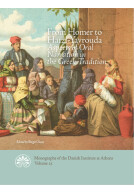Landscape as World Picture: 2-Volume Set (Hardback)
Tracing Cultural Evolution in Images
Imprint: Aarhus University Press
Pages: 1099
Illustrations: colour & b/w illus
ISBN: 9788779342873
Published: 30th June 2009
Script Academic & Professional
Pages: 1099
Illustrations: colour & b/w illus
ISBN: 9788779342873
Published: 30th June 2009
Script Academic & Professional
You'll be £95.00 closer to your next £10.00 credit when you purchase Landscape as World Picture: 2-Volume Set. What's this?
+£4.99 UK Delivery or free UK delivery if order is over £40
(click here for international delivery rates)
Need a currency converter? Check XE.com for live rates
(click here for international delivery rates)
Need a currency converter? Check XE.com for live rates
These two volumes present a new and comprehensive theory concerning the manner in which landscapes in Western pictorial art may be interpreted in relation to the cultures that created them. Its point of departure is a hitherto unexplored developmental pattern that characterises landscape representation from Palaeolithic cave paintings through to 19th-century modernity. A structuralist comparison between this pattern and three additional fields of analysis -- self-consciousness, socially-determined perception of nature, and world picture -- reveals a fascinating insight into culture's macrohistorical organisation. Controversially, this book argues that culture at a certain level of observation is marked by directional evolution. In Volume I the author traces the pictorial depth of field from its Palaeolithic beginnings, in which only separate bodies are portrayed, and on to antiquity and the Middle Ages with their quasi-perspectival vistas. This gradual accentuation of a viewpoint is interpreted as a sign of how self-consciousness -- the notion of an T detached from nature -- develops. Similarly, the raw rocky terrain and vividly coloured skies that are introduced in ancient and medieval landscape images are taken as a testimony of how cosmos splits into a chaotic Mother Earth and an indestructible masculine heaven. Finally, Volume I demonstrates that the ancient landscape images' exclusion of traces of cultivation (e.g. fields, roads, hedges, fences) is the result of work-shyness, a longing for the Golden Age, among the powers-that-be. The topic of Volume II is the breakthrough of the modern landscape image and its new perspectival vistas, transient time and cultivated - or completely deserted - terrains. This post-medieval paradigm shift is construed as the mature stage in the evolution of self-consciousness, with an urban individual contemplating nature at an aesthetic distance. Apart from being structurally equivalent with the new Copernican cosmos and the colonial expansion of Western culture, the new territorial landscape image is shown to develop in close interaction with the early modern work ethic, republicanism and capitalism. It is also demonstrated that this landscape image is at odds with the idealising Italian Renaissance vision, a conflict condensed in the imagery of strangely artificial rock formations.
Other titles in Aarhus University Press...













